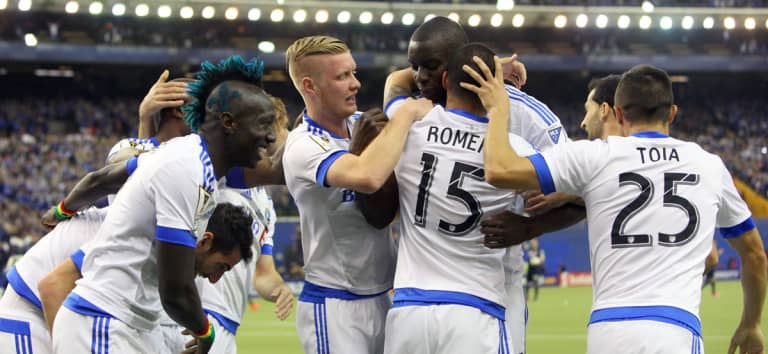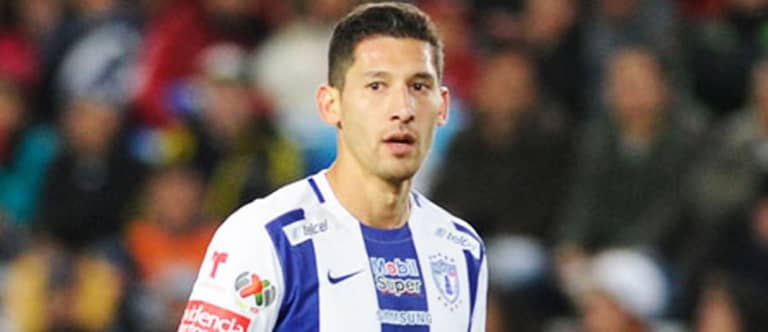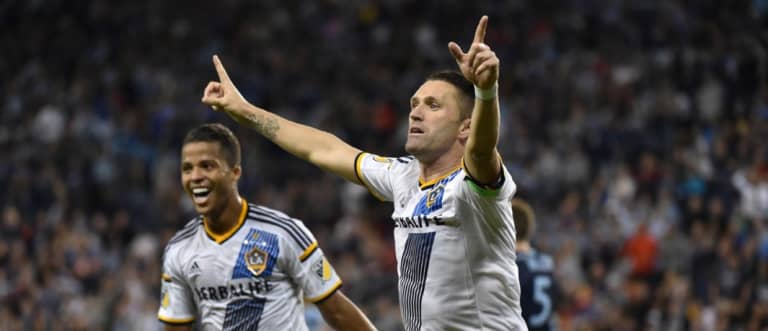Real Salt Lake forward Alvaro Saborío sat hunched over on the Rio Tinto Stadium pitch. All around him, Monterrey players and coaches celebrated. A dream, eight months in the making, was dead.
Thanks to an Humberto Suazo goal, scored a few seconds before the end of the first half, Rayados were 2010-11 CONCACAF Champions League winners. In eight months, they’d head to Japan for the Club World Cup and matches against UEFA Champions League holders Chelsea and African Champions League giants Al-Ahly on the way to a third-place finish.
While his players prepared to lift the cup, Monterrey manager Victor Manuel Vucetich approached the distraught Costa Rican international, the tournament’s second-leading scorer, and offered a few words of quiet encouragement. His team had made history – but just barely.
“It is satisfaction, it is joy,” Vucetich said shortly after the 3-2 aggregate victory, what would be the first of three consecutive CCL triumphs at the helm of a golden age in Monterrey. After a brief pause, he continued. “For Real Salt Lake, I have only praise.”
His words, as well as his tone, were vastly different from a week prior, when he reproached RSL for “dirtying the game” with physical play following a 2-2 first-leg draw at Estadio Tecnológico. And yet, that April 2011 night was a watershed of sorts, a devastating loss for RSL, but also a clear indicator of what was to come. Slowly but surely, the rivalry between the leagues had become less one-sided.
“The door was kicked down, and you saw people [in Mexico] take notice of American soccer in general,” says former US international Herculez Gomez, who lost twice to Monterrey in consecutive CCL finals as a member of Santos Laguna.
Prior to that year's tournament, Liga MX hadn’t had much reason to take notice. MLS hadn’t won a single match (0-10-4) against Mexican clubs in the two years since the competition changed format. In the five editions after, MLS have cobbled together a much-improved 11-23-10 record against their southern neighbors. Twice MLS teams have ousted their Mexican counterparts in the knockout stages.
Almost five years after RSL’s magical run to the final, a burgeoning sense of respect spurred by the Montreal Impact’s own run to the final in 2015 and an increasingly shared player pool marks the CONCACAF Champions League quarterfinals, where for the first time since the current format was adopted in 2008, Liga MX and MLS teams will face off head-to-head in all four series as close to equals than they've ever been before.
"If this game was 30 years ago, there wouldn't be any questions [about the differences between Liga MX and MLS], but soccer has evolved so much in CONCACAF, like Mexico's has," Tigres head coach Ricardo Ferretti said ahead of his team's series vs. RSL. "But it's more notable over there because their soccer was very distant to the one we used to play, and today it's almost identical."

Last April, ahead of the CONCACAF Champions League final, many Mexican newspapers and a legion of pundit-laden television and radio shows jumped on an eye-catching but ultimately misleading headline: worst against first.
While it was certainly true that the Montreal Impact were rooted to the bottom of the MLS standings at the time – given little to no chance against Club América, Liga MX’s most successful and talked about club – even a cursory search would have exposed that storyline as mostly hollow. With just four games under their belts thanks to rescheduling facilitated by the league office, the Impact and MLS were simply prioritizing a competition they desperately wanted to win.
The title was América’s to lose, according to the prevailing logic. It was as if Montreal’s dramatic quarterfinal win against Pachuca – not to mention El Tri’s shrinking CONCACAF winning percentage, attributed by the same pundits to growth of other domestic leagues in North and Central America – had been forgotten.
As turned out, Las Águilas emerged from the final with their sixth CONCACAF title, but they did so battered and bloodied, both proverbially and physically. The region’s biggest club was unable to win at Estadio Azteca, and their first aggregate lead didn’t come until the 64th minute of the return leg.
Even with the mission accomplished and a spot in the Club World Cup booked, the establishment’s tone suddenly changed with time to reflect on América’s road to victory. Montreal and MLS were exalted in defeat, and 2011’s lesson was relearned.
“Congratulations to the Impact, who have a great team and a great coach and are building something good here,” head coach Gustavo Matosas told MLSsoccer.com after the comeback win, harkening back to Vucetich’s words that night in Sandy, Utah.
Come December, it seemed clear Matosas’ opinion was shared by his Liga MX colleagues. Only they spoke with their wallets.

In Mexico, fans have long been accustomed to seeing their favorite squads acquire the bulk of their new signings from the same group of familiar names: River Plate, Boca Juniors, Colo-Colo, Sao Paulo. There were more than a few eyebrows raised when, prior to the Clausura 2016 season, it was the Portland Timbers, Real Salt Lake and LA Galaxy who were supplying fresh talent.
In December, when Club Tijuana decided to purchase Juninho’s contract from the LA Galaxy, the Brazilian became the team’s third player on its active roster with MLS roots, alongside former Union defender Michael Orozco Fiscal and Galaxy academy product Paul Arriola.
Tijuana’s signing of the Brazilian midfielder, a three-time MLS Cup winner, was just one MLS-to-Liga MX signing sandwiched amidst other transfer headlines that week, with the Timbers’ Jorge Villafana (Santos Laguna), RSL’s Luis Gil (Queretaro) and Luis Silva (Tigres) and former LA teammate Omar Gonzalez (Pachuca) also making the jump.
The quartet wasted no time making an impact in their new environment.
Villafana, fresh off an MLS Cup victory with Portland, started six of the season’s first seven games for an ambitious young Santos side that will take on LA in its own CCL quarterfinal. Gil’s played in five of Queretaro’s seven games ahead of their matchup with D.C. United, and Juninho gradually forced his way into Miguel Herrera’s XI after a settling-in period at Tijuana.
Gonzalez, meanwhile, emerged as one of the winter’s best signings. Hailed as one of the key players for Pachuca, a sudden title contender, the former Galaxy center back has started every game thus far for the second-best defense in Liga MX while reinforcing his reputation as a set-piece threat with a late equalizer against Pumas on Feb. 7.
“He’s in his prime. He’s been a big player for club and country, and any player like that is an asset,” says Toronto FC striker Gomez, who played in Mexico for five years, including a stint with Los Tuzos, winning a Golden Boot and repeatedly breaking MLS hearts in the CCL, primarily with Santos Laguna. “[The growing respect for MLS] is a huge compliment for the league and these players in general.”
Of course, as Gomez’s experience attests, movement between Liga MX and MLS is not new – the early days of MLS featured a heavy dose of El Tri stars, such as Carlos Hermosillo, Jorge Campos and Luis Hernandez, among others – but the sudden push for established MLS talent, prospective starters instead of depth signings or youth prospects, is a new wrinkle to the story.
In MLS, Mexican team officials increasingly see a league on the rise, with proven talent worthy of their investment. In Mexican-Americans such as Gonzalez, Gil, Silva and Villafana, they also get the flexibility to venture outside the domestic talent pool without using one of five foreign roster spots.
Within the country, the shift in player acquisition has been seen largely as an arms race between Mexican teams to acquire top talent from a new and emerging market. It is also, at least in part, a direct response to the growth and development of MLS, and there’s no reason to suspect the momentum will slow anytime soon.
“[It shows] we’re growing in the US and the young talent in MLS is getting better and better,” says US international Greg Garza, whose dual-national status helped him transition smoothly to Club Tijuana in 2012.

Growth is good, but MLS recognizes that at some point the league must assert itself in the region and deliver a CCL championship to reinforce it’s ambition to be among the world’s best by 2022.
And while 2016 represents an unprecedented opportunity to set up two all-MLS semifinals and a guaranteed spot in the final, there’s no denying the opposite – a Liga MX sweep in the quarterfinals and another CCL dream dead – is also a distinct possibility.
This year, in what most consider the marquee series, defending champions América must get past the Seattle Sounders in order to seriously plot a back-to-back run. The pressure is on the Mexican giants and embattled manager Ignacio Ambriz, who has spent all of 2016 on the hot seat. The Sounders must do without the talisman Obafemi Martins, reportedly on the brink of a move to the Chinese Super League.
Vucetich, now at the helm of Querétaro, will test his young squad’s mettle against D.C. United, a matchup that will reunite him with Saborio. Querétaro’s form has largely dipped following an Clausura 2015 finals run, and they’ll limp into their showdown with the Black-and-Red in 13th-place after seven games, considered by many the underdog in the two-leg series.
At the other end of the spectrum, Real Salt Lake will have a chance to recapture their 2011 magic against a dominant Tigres squad that barreled to their fourth league title just two months ago on the back of French superstar Andre-Pierre Gignac, a signing that was half-jokingly referred to by many fans and media as “a Designated Player for Liga MX.”
Finally, a rebuilding Santos side will face off against the Galaxy in the same boat but with an expectation that this could finally be the year they mount the deep CCL run. As Giovani dos Santos prepares to play a meaningful match at the club level in Mexican territory for the first time in his career, Villafana will come face to face with MLS for the first time since heading south.
“Now I’m representing a different league, and it’s going to be fun to go back to Los Angeles and my hometown,” Villafana, who made his professional debut with Chivas USA, told MLSsoccer.com on Saturday. “I’m excited. Whenever I’ve played against [LA], I’ve had a good game. There’s something about that stadium that brings me good luck.”
Make no mistake, like RSL and the Impact before them, this year’s quarterfinal entrants will need a little luck to advance to the semifinals, let alone the finals. Still, with rosters and results against Mexican clubs improving, there is cautious hope that a third bite at the CCL final apple could end with history.
For Liga MX, their neighbor’s growth has become impossible to ignore. On Tuesday, the region’s dominant force will once against defend its last bastion of absolute dominance, against a competitor that yearns to do the consoling this time around.













